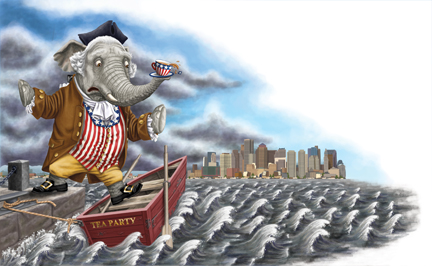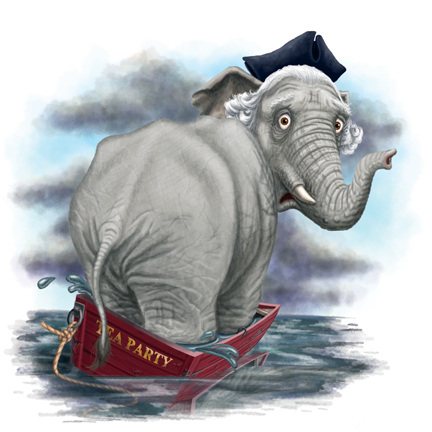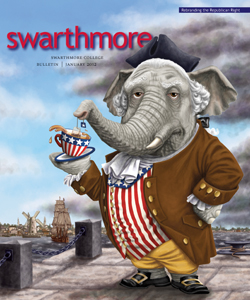Re-branding the Right
The Tea Party and its sympathizers are virtually one and the same as another highly visible political movement with low approval ratings: the Christian Right.
 THE NAME AND THE STORY EVOKE A STIRRING CHAPTER FROM THE COUNTRY'S PAST. Good, patriotic Americans become fed up with a distant, out-of-touch, over-reaching tyrannical government. From a wellspring of discontent arises something wholly new and spontaneous, a broad-based popular uprising determined to throw the rascals out of power, like so much tea into Boston Harbor.
THE NAME AND THE STORY EVOKE A STIRRING CHAPTER FROM THE COUNTRY'S PAST. Good, patriotic Americans become fed up with a distant, out-of-touch, over-reaching tyrannical government. From a wellspring of discontent arises something wholly new and spontaneous, a broad-based popular uprising determined to throw the rascals out of power, like so much tea into Boston Harbor.
This portrayal of today’s Tea Party and its genesis has proven irresistible to the media and popular understanding—as well as one of the nation’s two predominant political parties, which in the run-up to the 2012 national elections seems ever more in the Tea Party’s sway.
One problem: The story is largely false.
Leave it to Robert Putnam ’63 to spoil the party. In view of Putnam’s career—his unique penchant for cutting through political fog and academic inscrutability to describe America—it hardly seems a surprise that this high-profile Harvard professor and best-selling author would play a major role in debunking the Tea Party myth, and, in so doing, contribute to a deeper public understanding of what’s happening in the body politic approaching the next big election.
“In most respects the evidence from our research tells a very, very different story about the Tea Party’s origins than what the Tea Party says about itself,” says Putnam, the Malkin Professor of Public Policy at Harvard University. “People—including the mainstream media—have been too much taken in by this story, which in almost every respect is flawed. Given what we have found, the notion that the Tea Party should be seen as a driving force in this election year is, frankly, nuts.”
Putnam and his collaborator and co-author, David Campbell, laid out their eye-popping conclusions in a New York Times op-ed in August, the summer’s debt-ceiling drama still fresh in the public’s mind. “Crashing the Tea Party,” read the headline. Crash the party it did, declaring, “The Tea Party is increasingly swimming against the tide of public opinion: among most Americans, even before the furor over the debt limit, its brand was becoming toxic.”
The Times piece previewed a more lengthy analysis that appears in the paperback edition, released in January, of Putnam’s and Campbell’s award-winning 2010 book American Grace: How Religion Divides and Unites Us. (Putnam gave a talk by the same name on campus last semester.) Not only did the Times piece point out the surprisingly low approval ratings of the Tea Party—20 percent, according to their surveys, as against 40 percent who disapprove—but it cited new evidence that the Tea Party is anything but the grassroots uprising many thought.
Mining a database comprising some 3,000 interviews conducted for American Grace, Putnam and Campbell controlled for various factors—attitudes on immigration, racial minorities, the role of religion in politics, and so on—and gleaned an important insight. The Tea Party and its sympathizers are virtually one and the same as another highly visible political movement with very low approval ratings: the Christian Right.
A myth and a re-branding strategy—exposed and debunked, with important implications for voters’ decisions and both political parties’ strategies in a presidential election year. Not a bad day’s work for a political scientist. And not the kind of outcome one could have foreseen for an aspiring mathematics and physics major named Robert Putnam who arrived on the Swarthmore campus in 1959.
“Swarthmore was the most important thing that ever happened to me, period,” Putnam says. “Swarthmore is where I met my wife, where I became intellectually open and alive, and where I became involved politically and socially. That intense interest in public service and public affairs is an extremely powerful part of the Swarthmore culture, and I drank that in.”
Putnam met his future wife, Rosemary Werner ’62, in a political science class. On their first date, she took him to a Kennedy-for-President rally. On their second date, Putnam, whose politics then ran in a Republican direction, returned the favor and took her to witness a Nixon motorcade working its way along Chester Road at the foot of the Swarthmore campus. It was only fitting that they would make a train ride to Washington, D.C., that following January to attend the Kennedy inauguration.
“We heard it with our own ears when Kennedy said those famous words, ‘Ask not what your country can do for you, but what you can do for your country,’” Putnam recalls. “I know it sounds awfully trite, but at the time, and even right now, that was an enormously important moment for me. The hair on the back of my neck stands up when I think about it. I don’t want to say that moment alone changed my life, but being at Swarthmore in those years did change my life. I moved from physics and mathematics to taking courses in political science and history, to majoring in psychology. I became more and more convinced that it was my duty to apply what skills and talents I had to studying things that would be relevant to public life.”
Today, if you ask close observers of American culture and politics about Robert Putnam and his impact on the culture’s understanding of itself, you will often hear echoes of this comment by pollster and religion analyst Robert Jones, who has also done groundbreaking work on the overlap between the Tea Party and Christian Right. “It’s one of Putnam’s gifts,” says Jones, CEO of the Washington-based Public Religion Research Institute, “that he can write books with really rigorous methodologies that can stand up in any academic circle but that have memorable phrases that are immediately understandable to wider audiences and encapsulate a whole complex set of sociological findings. That’s the mark of someone who’s a real public intellectual.”
Bowling Alone. That was one eminently memorable and telling phrase coined by Putnam, and also the title of his 1995 best-selling book. Putnam struck a chord with his chronicling of the dissipation of face-to-face social interactions (such as those that take place in bowling leagues), and the measureable correlations with declining levels of civic participation. Through its use of that haunting term “bowling alone,” the book, in retrospect, seems to foreshadow the rise of the hyper-individualism that has found its political expression more recently in political phenomena like the Tea Party.
Also near the top of any list of classic Robert Putnam phrases must come “The Aunt Susan Principle.” Used to great effect in his and Campbell’s American Grace, the term does a great deal to explain the apparent paradox posed in the book’s subtitle: “How Religion Divides and Unites Us.”
Think of it this way: Aunt Susan is the person in your life who might have vastly different religious ideas but whose simple decency and kindness make it impossible for you to demonize her and that “other” group of which she is part. “All of us have an Aunt Susan in our lives,” Putnam explains, “someone who is just wonderful, but who happens to be of a different religion from mine.”
Imagine that you are an evangelical Christian and your “Aunt Susan” is an agnostic. Even though the orthodoxy in your religion tells you she is in the dark and barred from heaven—perhaps even someone who should be kept at arm’s length lest she exert a bad influence on you—your experience and your heart tell you something quite different. And you come to realize that you do not believe she is bad or destined for hell. Putnam and Campbell, through their exhaustive interviews and analyses for American Grace, discovered that this is how America has become increasingly tolerant on matters of religion even in the midst of a highly visible culture war.
 “The more Aunt Susans you have in your life,” Putnam explains, “the more tolerant you become of all religions. These ties, which have grown a lot in the past 50 years, have produced this remarkable level of religious tolerance in America despite religion, in some other respects, becoming more polarizing.”
“The more Aunt Susans you have in your life,” Putnam explains, “the more tolerant you become of all religions. These ties, which have grown a lot in the past 50 years, have produced this remarkable level of religious tolerance in America despite religion, in some other respects, becoming more polarizing.”
His knack for ultra-revealing phrases like the Aunt Susan Principle is not something Putnam traces back to an aunt, but to his mother-in-law.
“Zelda, who is no longer alive, sadly, was smart but not particularly well educated,” Putnam says. “She had an extremely low tolerance for social science. Thirty years ago, I vowed I was going to write as much as I could in language that Zelda would understand. So, quite consciously, I spend a lot of time thinking, ‘How can I explain my research to Zelda, my mother-in-law?’”
Richard Valelly ’75, Claude C. Smith 1914 Professor of Political Science, calls Putnam the rare political scientist who is interested in, and able to capture, the non-political contexts that affect politics. “Most of us who study American politics study conflict, political parties, public opinion, the evolution of the filibuster and its implications for policy-making, and the like,” Valelly says. “That stuff is fascinating and important. But the broad societal context is often missing—and Putnam has pioneered ways to understand that context and to analyze its evolution and meaning for the quality of life in America. He is interested in how seemingly non-political phenomena—the linkages between social capital and trust, the religiosity of Americans and its connection to tolerance of differences—create the background context for a fundamental concern, namely, American greatness.”
Were someone looking for a homespun phrase to explain the implications of Putnam’s latest research, he or she might well end up with “the tail that wagged the dog.” Judging solely from the media fascination with the Tea Party and the large amount of coverage devoted to it, and considering the way the Republican presidential contenders spent fall 2011 catering to it, one might conclude that support for this movement was broad and deep—a true force to be reckoned with. And, as revealed by Putnam and his political science collaborator from Notre Dame, one reaching this conclusion would be deeply mistaken.
It’s putting it mildly to say the Tea Party is unpopular; as Putnam and Campbell find, its approval ratings turn out to be lower than Muslims and atheists—two social groups that appeared to have staked permanent claim to the bottom rungs of the ladder in American public opinion. As the research pair pointed out in their New York Times op-ed, it was telling that the Christian Right also emerged as one of the lowest-scoring cohorts when they asked people to evaluate such groups as blacks, Hispanics, Democrats, Republicans, etc.—telling, because it turns out that the Tea Party and Christian Right are closer to being one and the same than researchers and journalists had previously realized.
To explore the complex dynamics of the Tea Party and its true origins and motivations, Putnam and Campbell returned to the people they surveyed in 2006 and 2007 for American Grace, probing this time for their views of the Tea Party. By controlling for various factors, the researchers found that the most significant predictors of Tea Party affinity were not stuff of Tea Party myth, not some new disgust with big government, national debt, and a reeling economy. Rather, they were the same factors that predicted Christian Right affiliation before there even was a Tea Party or a Barack Obama in our national politics. Those who ended up becoming Tea Party supporters were, back in 2006 and 2007, overwhelmingly white Republicans with a predilection against immigrants, a coolness toward blacks and other minorities, and, most significantly, a conviction that religion—Christianity, to be exact—should infuse politics.
“The religious right has been around in Republican politics for a long time,” Putnam says. “The Tea Party turns out to be, by and large, the same folks. Frankly, it’s a different label for the same old group.”
A different label, to be sure. But another important difference is the political context. Now, unlike in 2006 or 2007, the country is gripped by a tenacious economic downturn and, moreover, the White House is occupied by a Democrat who has become a focal point for otherwise inchoate anger about the dysfunctions of the federal government. William Saletan ’87, a longtime politics writer for Slate, points out that the Tea Party, as often happens with political movements, can partly attribute its sudden rise to being in the right place at the right time. If not for the economic downturn, Saletan says, the Tea Party would have nowhere near the media visibility and political clout it now enjoys.
“The Tea Party is the angry movement that happened to be standing there as the recession deepened,” Saletan said in an interview. “Were it not for the recession, people would be relatively happy with the U.S. government. The troops are coming home from the unpopular wars. Foreign policy is not going badly; people are feeling more secure. There’s not a big outrage about social issues. If the economy were OK, there would not be this great anger at the government. And the Tea Party would make no sense.”
Putnam believes his and Campbell’s findings are highly relevant to Republican strategies for 2012—and well beyond. Smart GOP game-planners, he says, will realize that the Tea Party has far narrower appeal than surface appearances might suggest, and that the attributes that give it clout in the GOP presidential nomination process—money, intensity, high levels of commitment—do not carry over well to a general election. “Although candidates like Michele Bachmann and Rick Perry are perfect for the Republican nominating constituency,” Putnam says, “they are perfectly awful for the general election.”
But the implications extend well beyond this next big election. Putnam points out that the signal markers of the Tea Party, in terms of its supporters’ demographic profile and their attitudes on issues and social trends, are on the wrong side of the shifting historical tides. The country is becoming more racially and religiously diverse. Younger members of the majority are themselves becoming more appreciative of tolerance and pluralism. Those who identify strongly with the Tea Party, Putnam notes, tend to be significantly older. While that helps account for the outsize sway they currently exert—older citizens tend to out-hustle younger Americans in the political arena, both in their donating and voting—it also suggests that the movement probably lacks staying power. “We can see from the data,” Putnam says, “that the views that distinguish the Tea Party are on their way out.”
Even if it pays off in the 2012 election, if the Republicans allow themselves to be defined by the Tea Party they could experience a fate similar to that which befell Democrats following the 1972 presidential contest, Putnam warns. He sees a parallel between the Republicans’ relationship with the Tea Party today and the relationship the Democratic party had with the anti-Vietnam War movement in the early 1970s—a relationship that was cemented by George McGovern’s nomination. While it brought energy to the party, it also alienated larger numbers of moderates and left the Democrats vulnerable to damaging characterizations that Republicans used to great advantage over subsequent years and decades.
“If Republicans allow the Tea Party’s views to define their image,” Putnam warns, “they risk smearing their party’s brand for a very, very long time.”
 Email This Page
Email This Page